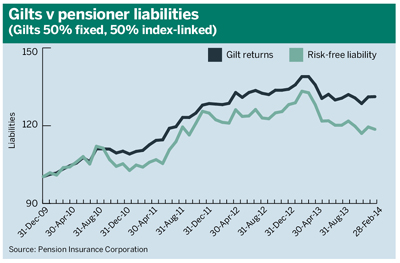Data analysis: Equity market performance and gilt stability could make it better value for schemes to lock in any funding gains, according to market commentators
Liabilities: the consultant’s view
The chart shows that February 2014 saw pensioner buy-in pricing affordability improve for schemes holding gilt assets.
The main driver affecting buy-in pricing was a marginal rise in swap yields. In contrast, gilt yields and the additional yield on corporate bonds over gilts remained relatively steady over the month. This resulted in slightly more attractive conditions to exchange gilts for a pensioner buy-in compared with previous months.

Focusing on credit spreads in particular, these have contracted considerably since the banking crisis. In the immediate future, while unrest in eastern Europe continues, short of a dramatic change in trajectory, the market appears to have priced in this current conflict.
So, in the absence of any further political unrest, relatively stable market conditions would suggest these levels may persist, or spreads might even tighten.
To counteract this effect, insurers have looked to alternative investments, such as infrastructure, social housing investment and wider corporate bond markets to offset some of the lower returns from UK corporate bonds.
In combination with broadly stable gilt yields, equity market performance has improved scheme funding more generally. After January’s sharp falls, equity markets rose steadily over February. Most regions were up mid-single digits in local currency terms. Emerging markets continued to lag their developed counterparts as negative headlines in Ukraine suppressed gains in other developing regions.
The overall improvement, with equities up and gilts remaining stable, suggests pension schemes will be increasingly looking to capture any funding gains by locking in buy-in prices. The continued appetite from insurers means pricing should remain competitive over the remainder of 2014, subject to demand not overtaking supply.
Emma Watkins is head of buyout business development at consultancy LCP
Affordability: the provider’s view
The Financial Times carried an interesting story earlier this month, reporting: “One of the world’s most respected investors [the head of the $27bn (£16.3bn) Baupost Group] has raised the alarm over a looming asset price bubble… warning of the potential for a brutal correction across financial markets.”
However, the group’s head Seth Klarman went on to say that investors were not prepared for the end of quantitative easing, although he could not predict when that might be, nor when any correction might come.

This is interesting because just by looking at what is happening in the economy and the markets, trustees could perhaps be forgiven for some confusion. There are lots of economic and financial data to suggest the UK is moving forwards, and strongly. For example, equities continue to do well, with the FTSE 100 finishing February well ahead of where it started.
And in its latest report the British Chambers of Commerce said it expected the UK’s GDP to return to its pre-recession peak later this year. It also expects the economy to expand fairly rapidly which, combined with others’ views of the economic growth we’re seeing, should be cause for celebration.
But we are not there yet. There remain significant risks, not least the fact that the recovery seems to be built on consumer demand and rising house prices.
As the chief economist at the BCC noted: “The UK’s current account deficit remains excessive, and without a stronger rebalancing towards net exports, we could face serious risks to our long-term economic health.”
So trustees appear to be caught in something of a dilemma: how to make the most of the good economic and financial news while positioning themselves for risks that certainly exist and which influential voices continue to point out.
Jay Shah is co-head of business origination at Pension Insurance Corporation














